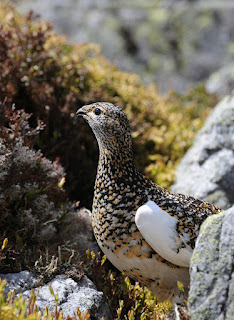 |
| A cock rock ptarmigan Lagopus muta sits on top of a rock watching over his mate as she feeds below |
Although the weather has been clear, dry, sunny and warm in the Scottish Highlands over the past week, the ptarmigan are late in laying their eggs this year. A sign of how cold the weather had been before the current warm spell.
 |
| Ptarmigan habitat of short, wind-swept heath on the high ridge of Ben Klibreck |
I was up Ben Klibreck in northern Scotland a few days ago, and other hills since, recording the food plants that ptarmigan were feeding on. The females should have been incubating their eggs by now as they often hatch in the first week of June, but this year they seem to be about two-three weeks behind their normal schedule. Ben Klibreck is 961m high and the ptarmigan habitat extends down to about 650m. So, any effects of a cold spring will be especially evident at that altitude, and the leaf buds of their main spring food plant in Scotland, bilberry Vaccinium myrtillus were only just opening.
At this time of year, the cock ptarmigan stay close to their hens, guarding them from competitors and keeping a watch for predators, mostly golden eagles in this area.
 |
| A hen ptarmigan in full breeding plumage |
This hen seemed to be heavy at the rear end, she probably had an egg well formed in her egg duct which would soon be ready for her to lay. Compare the profile of her body beneath her tail with that of the cock bird's slimmer line.
 |
| A cock ptarmigan his full breeding plumage |
Part of the reason for the bird's lateness in laying is probably due to the late development of the birds' food-plants. These are sparse in the north-west Highlands, and although the ptarmigan do live there successfully on what seems to us seems a scant food supply, to form a clutch of eggs, the hens might need the extra nutrients that the developing new growth brings.
 |
| Sparse food plants for ptarmigan amongst a carpet of woolly fringe moss |
The bilberry was growing in short, thinly scattered sprigs, and there was a similar scattering of stiff sedge Carex bigelowii. I watched one hen picking out the flower spikes from the sedges, delicately and precisely nipping off only the most nutritious parts and avoiding eating much of the stems which are less nutritious. Another food-plant there was alpine lady's mantle Alchemilla alpina, of which they eat the flower buds as they form, but few had formed by last week. All three food-plants were growing in a carpet of woolly fringe moss Racomitrium lanuginosum, which made up about 90% of the ground cover in places. By living there on such meagre food supplies, the ptarmigan were showing once again how well they are adapted to life on the high tops.
 |
| Flower spikes of Stiff Sedge and opening leaves of Bilberry - the two main foods that the ptarmigan were eating that day. |





































